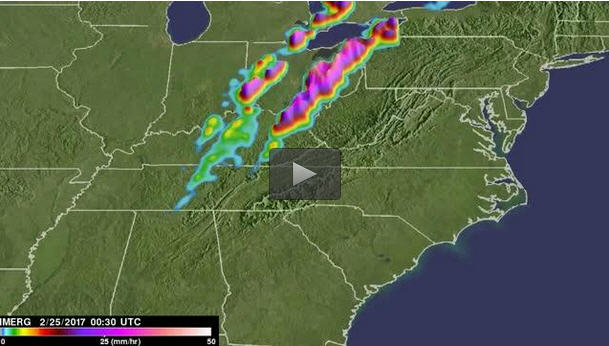NASA examines deadly spring-like weather with GPM satellite

This IMERG 3-D Flyby animation shows the movement of storms from Feb. 25 through Mar. 1. Credits: NASA/JAXA, Hal Pierce
Record breaking warm temperatures this winter have caused plants to bloom early in the eastern United States. Unfortunately this has also resulted in the formation of spring-like severe thunderstorms and deadly tornadoes. Multiple tornado sightings were made in three of the last seven days. On Saturday February 25, 2017 destructive tornadoes were reported in Maryland, Pennsylvania and Massachusetts.
On February 28, twisters were reported in the states of Arkansas, Iowa, Illinois and Michigan. Three people were killed in Illinois and four others were injured in Arkansas with this tornado outbreak. Severe weather on March 1, 2017 also included reports of tornado sightings in Ohio, Tennessee, West Virginia, Kentucky and Georgia.
Integrated Multi-satellitE Retrievals for GPM or IMERG data were used to show the rainfall that occurred during the past week. The analysis was done at NASA's Goddard Space Flight Center in Greenbelt, Maryland. Intense downpours from storms over this period resulted in flash floods in several states.
The GPM core observatory satellite had a good view of severe weather as it moved into the Appalachian Mountains on March 1, 2017 at 1525 UTC (10:25 a.m. EST). The GPM satellite measures rain and snow using the GPM Microwave Imager (GMI) and Dual-Frequency Precipitation Radar (DPR) instruments.
GPM's DPR measured rain falling at a rate of over 6.3 inches (159 mm) per hour as powerful storms moved through Tennessee and Kentucky. Storm top heights of over 32,800 feet (9.8 km) were found by GPM's radar as it sliced through those intense thunderstorms.
Due to above average temperatures, frozen precipitation, other than hail, was unusual over the eastern United States in the GPM analysis. GPM's radar data (DPR) showed that the average height of the freezing level was above 9,800 feet (3 kilometers).
In Alabama, the freezing level was much higher up. It was shown by GPM's data to be higher than 13,123 feet (4 kilometers).
GPM is a joint mission between NASA and the Japanese space agency JAXA. For more information about GPM, visit: http://www.
For forecasts, visit the National Weather Service's Weather Prediction Center website: http://www.
Media Contact
All latest news from the category: Earth Sciences
Earth Sciences (also referred to as Geosciences), which deals with basic issues surrounding our planet, plays a vital role in the area of energy and raw materials supply.
Earth Sciences comprises subjects such as geology, geography, geological informatics, paleontology, mineralogy, petrography, crystallography, geophysics, geodesy, glaciology, cartography, photogrammetry, meteorology and seismology, early-warning systems, earthquake research and polar research.
Newest articles

NASA: Mystery of life’s handedness deepens
The mystery of why life uses molecules with specific orientations has deepened with a NASA-funded discovery that RNA — a key molecule thought to have potentially held the instructions for…

What are the effects of historic lithium mining on water quality?
Study reveals low levels of common contaminants but high levels of other elements in waters associated with an abandoned lithium mine. Lithium ore and mining waste from a historic lithium…

Quantum-inspired design boosts efficiency of heat-to-electricity conversion
Rice engineers take unconventional route to improving thermophotovoltaic systems. Researchers at Rice University have found a new way to improve a key element of thermophotovoltaic (TPV) systems, which convert heat…



